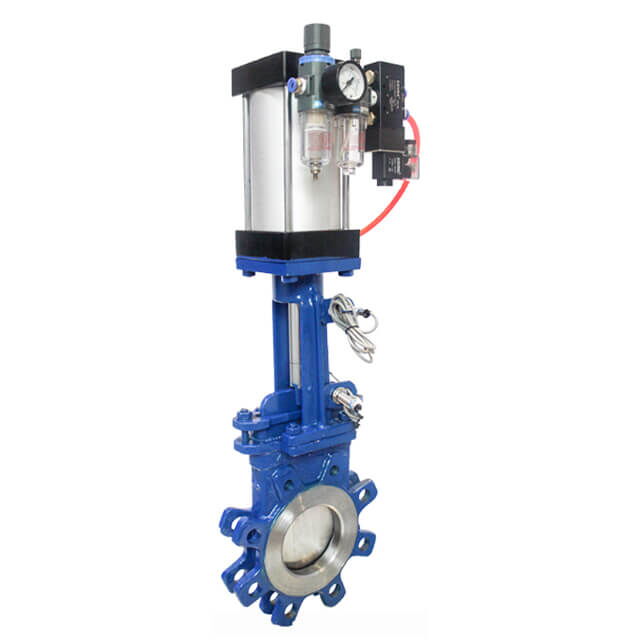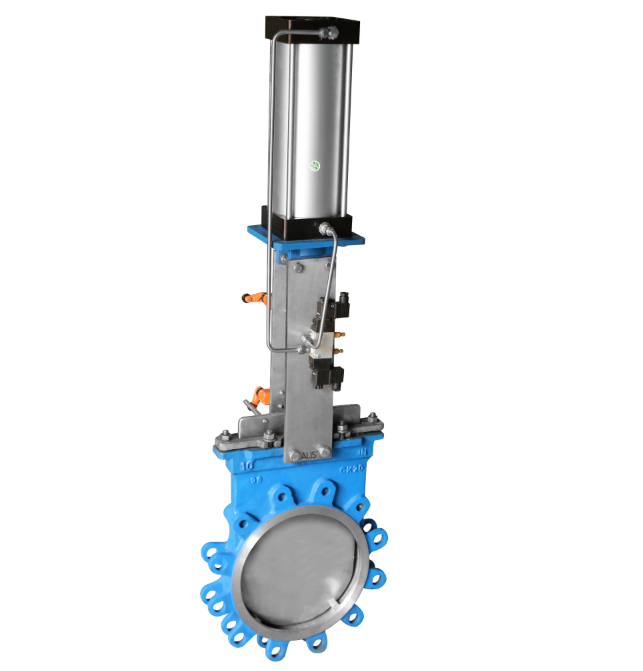
In modern industry, the smooth flow of liquids, gases, and slurries through pipelines is vital for operational efficiency and safety. Whether in mining, chemical plants, or pulp and paper facilities, the ability to reliably control challenging media often determines production continuity and cost-effectiveness. Among the many valves used across these sectors, pneumatic knife gate valves stand out for their unique ability to cut through difficult materials, provide tight shut-off, and deliver quick actuation with minimal manual intervention.
This article explores pneumatic knife gate valves in depth, from their working principles and structural features to their advantages, applications, and maintenance practices. By the end, you’ll gain a clear understanding of why these valves are indispensable in demanding industrial environments.

A knife gate valve is a specialized flow-control device designed to handle fluids containing suspended solids, viscous substances, or abrasive slurries. Its defining feature is a sharp-edged gate, or blade, which moves vertically within the valve body to open or close the flow path. Unlike conventional valves such as ball or globe valves, which may struggle when encountering thick media, the knife gate valve’s cutting action ensures that fibers, pulp, or granules do not obstruct the passage.
While knife gate valves are available in manual, electric, or hydraulic versions, pneumatic knife gate valves are increasingly preferred because they combine the cutting efficiency of the knife gate design with the speed and automation of pneumatic actuation.
The working principle centers on the interaction between the pneumatic actuator and the knife gate. Compressed air is used as the driving force. When a control signal is received, air enters the actuator cylinder, generating pressure that pushes the piston and drives the gate plate vertically.
Opening: The actuator lifts the knife gate upward, creating an unobstructed passage for the medium.
Closing: The actuator pushes the gate downward, cutting through fibers or solids and sealing against the valve seat.
This simple yet effective mechanism allows for rapid on-off control of liquids, gases, or slurry-like materials. Because pneumatic actuators can be integrated with positioners and automation systems, the valve can also achieve throttling or proportional adjustment, not just binary open/close control.
Pneumatic knife gate valves are designed with several features that make them highly effective in challenging industrial environments.
At the core of their functionality is the sharp-edged gate, engineered to cut through pulp, fibers, slurries, and other viscous materials. This design minimizes the risk of clogging and guarantees reliable shut-off, even when dealing with contaminated or particle-laden media.
One of the main advantages of pneumatic actuation is speed. These valves open and close quickly, making them well-suited for applications requiring frequent adjustments, emergency shut-off, or fast process control.
Built to withstand harsh conditions, pneumatic knife gate valves are commonly manufactured from stainless steel, ductile iron, or cast iron. These materials resist both corrosion and abrasion, significantly extending the valve’s service life, even in demanding environments.
Another key benefit is their space-efficient design. Unlike some other shut-off mechanisms, pneumatic knife gate valves require minimal clearance. This makes them ideal for installations where space is limited, ensuring flexibility without compromising performance.
Together, these features make pneumatic knife gate valves a reliable choice for industries handling abrasive, corrosive, or viscous media.
Each valve is made up of carefully engineered parts, all working together to ensure dependable operation:
Constructed from materials such as stainless steel or cast iron, the body withstands corrosive environments and abrasive slurries.
A flat, sharp-edged plate that moves vertically. Its cutting action ensures solids or fibers do not impede closure.
The pneumatic actuator converts compressed air into linear motion. Options include single-acting (spring return) or double-acting types for fail-safe performance.
Elastomers, PTFE, or reinforced polymers provide leak-tight sealing. Advanced designs prevent leakage under both high pressure and continuous operation.
Control devices such as solenoid valves, air filters, and regulators fine-tune performance, enabling precise and safe operation.
Valve body crafted from cast steel or ductile iron for strength.
Gate disc from stainless steel for corrosion resistance.
Optimized flow path minimizes media retention and enhances velocity distribution.
Available in double-acting (DA) and spring-return (SR) configurations.
Switching times as short as 20 milliseconds.
Modular air treatment units (filters, regulators, lubricators) extend system life.
Operating temperature range: -29°C to 650°C.
Pressure rating: 1.0 MPa to 2.5 MPa.
Optional PTFE or PPL packing materials for mildly corrosive fluids.
Supports DIN, JIS, ANSI, GOST, and 10K flanges.
Facilitates integration into both domestic and international projects without modifications.
The sliding gate ensures a clean cut through media, minimizing the risk of leakage and guaranteeing tight shut-off.
Unlike other valves that may clog, knife gate valves thrive in slurries, powders, and fiber-rich fluids.
Pneumatic operation allows for full integration into automated systems, reducing the need for manual operation.
With fewer moving parts and a simple mechanism, maintenance demands are significantly lower compared to more complex valve designs.
Compact design requires minimal clearance, which is advantageous in tight pipeline layouts.
Reduced downtime, lower maintenance, and long service life contribute to lower total cost of ownership.
Pneumatic knife gate valves are widely adopted in sectors where conventional valves fail to deliver reliable service:
Mining: Used for handling tailings, slurry transport, and thickened mineral concentrates.
Pulp and Paper: Ideal for cutting through pulp fibers and preventing clogging in paper mills.
Chemical Industry: Withstands corrosive chemicals and abrasive byproducts.
Power Plants: Controls ash slurry, cooling water, and other challenging streams.
Wastewater Treatment: Manages sludge, grit, and other solid-containing flows.
Food Processing: Handles viscous materials such as starches, grains, and fibrous products under hygienic conditions when stainless steel construction is used.
Like any industrial equipment, pneumatic knife gate valves require routine maintenance to ensure long-term performance:
Regularly inspect compressed air connections to prevent leaks and pressure drops.
Remove any buildup of solids or debris to prevent jamming.
Periodically lubricate moving parts, especially the cylinder and gate mechanism, to maintain smooth operation.
Replace worn or degraded seals promptly to maintain leak-tight performance.
Cycle the valve periodically to confirm proper functioning, particularly in systems where valves may remain in one position for extended periods.
In a chemical plant processing high-temperature steam, a pneumatic knife gate valve has operated continuously for over a year without adjustment, despite constant exposure to thermal expansion and contraction cycles. The valve’s corrosion-resistant stainless-steel gate, robust seals, and precision actuator design have eliminated downtime and reduced maintenance costs for the facility.
This example demonstrates the durability and reliability of pneumatic knife gate valves in some of the harshest operating conditions.
As industries continue to demand greater automation, efficiency, and sustainability, pneumatic knife gate valves will play an even more critical role. Advances in actuator technology, smart sensors, and materials engineering are paving the way for next-generation valves that:
Integrate with digital monitoring systems for predictive maintenance.
Offer self-cleaning gate designs to reduce downtime.
Utilize advanced alloys and coatings for longer service life in corrosive environments.
With global demand for energy, chemicals, and processed materials showing no signs of slowing, these valves will remain a backbone of industrial infrastructure.
Pneumatic knife gate valves combine the proven reliability of knife gate technology with the speed and automation of pneumatic actuation. Their ability to cut through solids, handle abrasive slurries, and deliver tight shut-off makes them indispensable in industries ranging from mining to wastewater treatment.
Key advantages such as compact size, fast response, durability, and compatibility with global standards ensure they remain one of the most versatile and cost-effective valve solutions available. By following best practices for maintenance and integrating them into automated control systems, industries can count on these valves to deliver uninterrupted performance for years to come.
As industries evolve and demands for efficiency rise, pneumatic knife gate valves are not just tools of today—they are also solutions for the future of fluid and slurry handling.